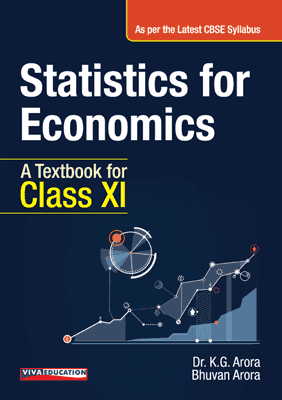Statistics for Economics
Statistics for Economics
A Textbook for Class XI (As per the Latest CBSE Syllabus)
₹450.00
Go to cartISBN: 9789388653015
Bind: Paperback
Year: 2019
Pages: 488
Size: 6.75 x 9.5 Inch
Publisher: Viva Education
Exclusive Distributors: Viva Books
Sales Territory: Worldwide
Statistics for Economics: A textbook for Class XI has been written in keeping with the latest syllabus prescribed by the Central Board of Secondary Education (CBSE). The book provides a clear insight into the theories of Statistics for Economics. The objective of writing the book is to offer students the means for grasping basics of statistics of economics.
Key Features:
- As per the latest CBSEINCERT syllabus
- Large number of solved illustrative examples, to help students understand concepts easily
- Key points, for quick revision of topics studied
- Exercise, to help students prepare for examination
- NCERT Textbook Questions, provided with answers
- Multiple Choice Questions (MCQs), to enhance students' active and self-managed learning
- Higher Order Thinking Skills (HOTS) questions, to help students apply the facts and concepts learned
- Solved Numerical Problems, given wherever required
Target Audience:
Students of CBSE Class XI Economics.
Contents:
Preface
Syllabus
Chapter 1: INTRODUCTION TO STATISTICS • What is Economics? • Definitions of Economics • Microeconomics and Macroeconomics • Significance of Economics • Economic and Non-Economic Activity • Economic Activities • Non-Economic Activities • Definition of Statistics • Statistics in Plural Sense (or Statistics as Data) • Statistics in a Singular Sense (or Statistics as a Science) • Statistics: As a Science and As an Art • Subject Matter of Statistics • Limitations of Statistics • Importance of Statistics in Economics • Exercises • NCERT Textual Questions with Answers • Multiple Choice Questions (MCQs) • Higher Order Thinking Skills (HOTS)
Chapter 2: COLLECTION OF DATA • Introduction • What is a Statistical Enquiry? • Source of Data • Primary and Secondary Data • Drafting of Questionnaire • Sources of Secondary Data • Difference between Primary and Secondary Data • Population versus Sample Surveys • Population • Sample • Census and Sample Surveys • Census or Complete Enumeration • Sample Surveys • Methods of Sampling • Random (or Probability) Sampling Method • Non-random Sampling or Non-probability Sampling • Statistical Laws • The Law of Statistical Regularity • Law of Inertia of Large Numbers • Some Important Sources of Secondary Data • Census of India • National Sample Survey Organisation (NSSO) • Sampling and Non-sampling Errors • Exercises • NCERT Textual Questions with Answers • Multiple Choice Questions (MCQs) • Higher Order Thinking Skills (HOTS)
Chapter 3: ORGANISATION OF DATA • Raw Data • Classification of Data • Meaning of Classification • Objectives of Classification • Types of Classifications • Variable • Frequency Distribution • Univariate Frequency Distribution • Bivariate Frequency Distribution • Exercises • NCERT Textual Questions with Answers • Multiple Choice Questions (MCQs) • Higher Order Thinking Skills (HOTS)
Chapter 4: STATISTICAL TABLES • Statistical Tabulation • Objectives of Tabulation • Distinction between Classification and Tabulation • Types of Tables • Functional Parts of Statistical Tables • Requisites of a Good Statistical Table • Importance of Table • Exercises • NCERT Textual Questions with Answers • Multiple Choice Questions (MCQs) • Higher Order Thinking Skills (HOTS)
Chapter 5: DIAGRAMMATIC PRESENTATION • Introduction • Advantages of Diagrammatic Presentation • Types of Diagrams • Difference between Diagrams and Graphs • Geometric Diagrams • Pie Diagram (or Pie Charts) • Pictograms • Exercises • NCERT Textual Questions with Answers • Multiple Choice Questions (MCQs) • Higher Order Thinking Skills (HOTS)
Chapter 6: GRAPHIC PRESENTATION • Introduction • Importance of Graphic Presentation • Contribution of Graphics • Guidelines for the use of Graphs and Diagrams in Presenting Data • Types of Graphs • Graphs of time series (or Historigrams) • Graphs of Frequency Distribution • Exercises • NCERT Textual Questions with Answers • Multiple Choice Questions (MCQs) • Higher Order Thinking Skills (HOTS)
Chapter 7: MEASURES OF CENTRAL TENDENCY • Measures of Central Tendency • Purpose and Functions of Averages • Essentials of a Good Average • Arithmetic Mean (A.M.) • Some Special Properties of the Arithmetic Mean • Calculation of Arithmetic Mean • Some special types of problems and their solutions • Weighted Arithmetic Mean • Combined Arithmetic Mean • Median • Calculation of Median • Calculation of median in individual series • Calculation of median in discrete series • Calculation of median in continuous series • Some special type of problems and their solutions • Merits and demerits or median • Mode • Determination of Mode • When data are either in the form of individual observations or in ungrouped frequency distribution (discrete series) • Method of Grouping • Some special types of problems and their solutions • Graphic Method of Locating Mode • Relationship between Mean, Median and Mode • Quartiles, Deciles and Percentiles • Quartiles • Calculation of quartiles, deciles and percentiles in individual series • Calculation of quartiles, deciles and percentiles in discrete series • Calculation of quartiles, deciles and percentiles in continuous series • Exercises • NCERT Textual Questions with Answers • Multiple Choice Questions (MCQs) • Higher Order Thinking Skills (HOTS)
Chapter 8: MEASURES OF DISPERSION • Introduction • What is Dispersion of Data? • Different Measures of Dispersion • Relative Measures of Dispersion • Range • Coefficient of Range • Inter-Quartile Range and Quartile Deviation and their Coefficient • Quartile Deviation (or Semi-Inter-Quartile Range) • Coefficient of Quartile Deviation • Calculation of Quartile Deviation (Q.D.) • Mean Deviation or Average Deviation • Coefficient of Mean Deviation • Calculation of Mean Deviation from Arithmetic Mean • Standard Deviation • Calculation of Standard Deviation (S.D.) • Coefficient of Variation (C.V.) • Lorenz Curve • Exercises • NCERT Textual Questions with Answers • Multiple Choice Questions (MCQs) • Higher Order Thinking Skills (HOTS)
Chapter 9: CORRELATION • Introduction • Types of Correlation • Degree of Correlation • Utility and importance of Correlation • Correlation and causation • The Correlation Coefficient • Methods of studying the correlation • Scatter Diagram (or Dot Diagram) • Karl Pearson's Coefficient of Correlation (or product moment Coefficient of Correlation) • Spearman's Rank Correlation • Case I: When the Ranks are Given • Case II: When the Ranks are worked out from the Data • Case III: When Marks are Repeated • Exercises • NCERT Textual Questions with Answers • Multiple Choice Questions (MCQs) • Higher Order Thinking Skills (HOTS)
Chapter 10: INDEX NUMBERS • Introduction • Definitions of Index Numbers • Types of Index Number • Characteristics of Index Number • Uses of Index Number • Problems Involved in Constructing the Index Numbers • Notation and Terminology • Methods of Constructing Index Number • Unweighted Index Number/ Unweighted Aggregate Index • Weighted Index Number • Consumer Price Index (CPI) or Cost of Living Index Numbers • Wholesale Price Index (WPI) • Index for Industrial Production • Index Number of Agricultural Production • Inflation and Index Number • BSE Sensex • Exercises • NCERT Textual Questions with Answers • Multiple Choice Questions (MCQs) • Higher Order Thinking Skills (HOTS)
Chapter 11: SOME MATHEMATICAL TOOLS USED IN ECONOMICS • Introduction • Dependent and Independent Variable • The Slope of Line • The Slope of a Curve • Curvilinear Positive Relationship • Curvilinear Negative Relationship • Vertical and Horizontal Curves • The Equation of a Straight Line • Exercises • Multiple Choice Questions (MCQs)
PROJECT WORK
CASE STUDIES
About the Authors:
Dr. K. G. Arora (PhD) is the Principal of SVM Yoga and Health Sciences College, Muzaffarnagar. He has a teaching experience of 25 years. Dr. Arora has taught Business Economics/Managerial Economics to B.Tech. and MBA students at IIT Roorkee, Saharanpur; where he has also served as a Guest faculty for four sessions. He has also authored several textbooks on Economics.
Bhuvan Arora did his M.Sc. in Economics from Doon University, Dehradun. Currently, he is working as an Assistant Professor at S.D. College of Management Studies, Muzaffarnagar.







